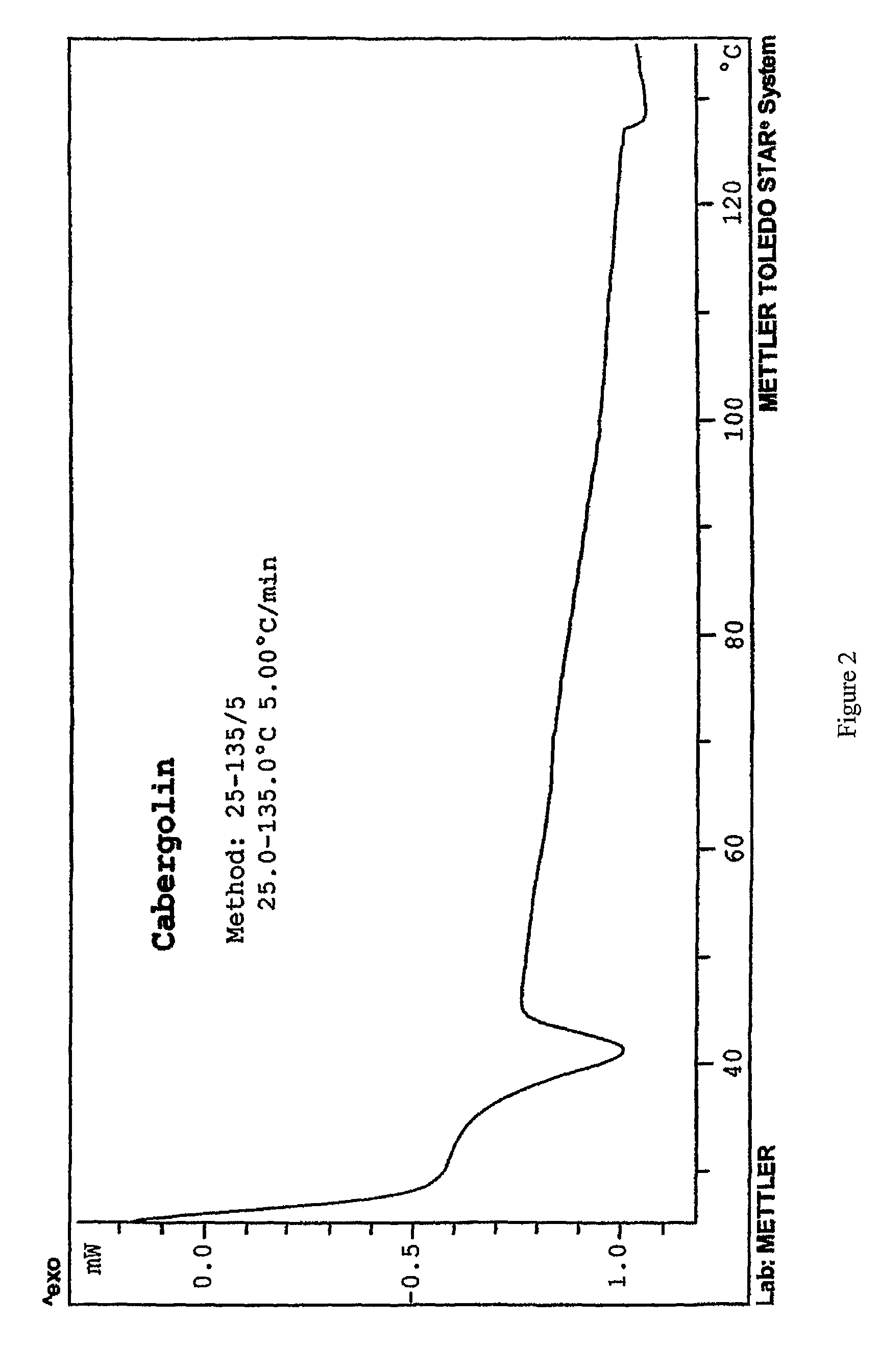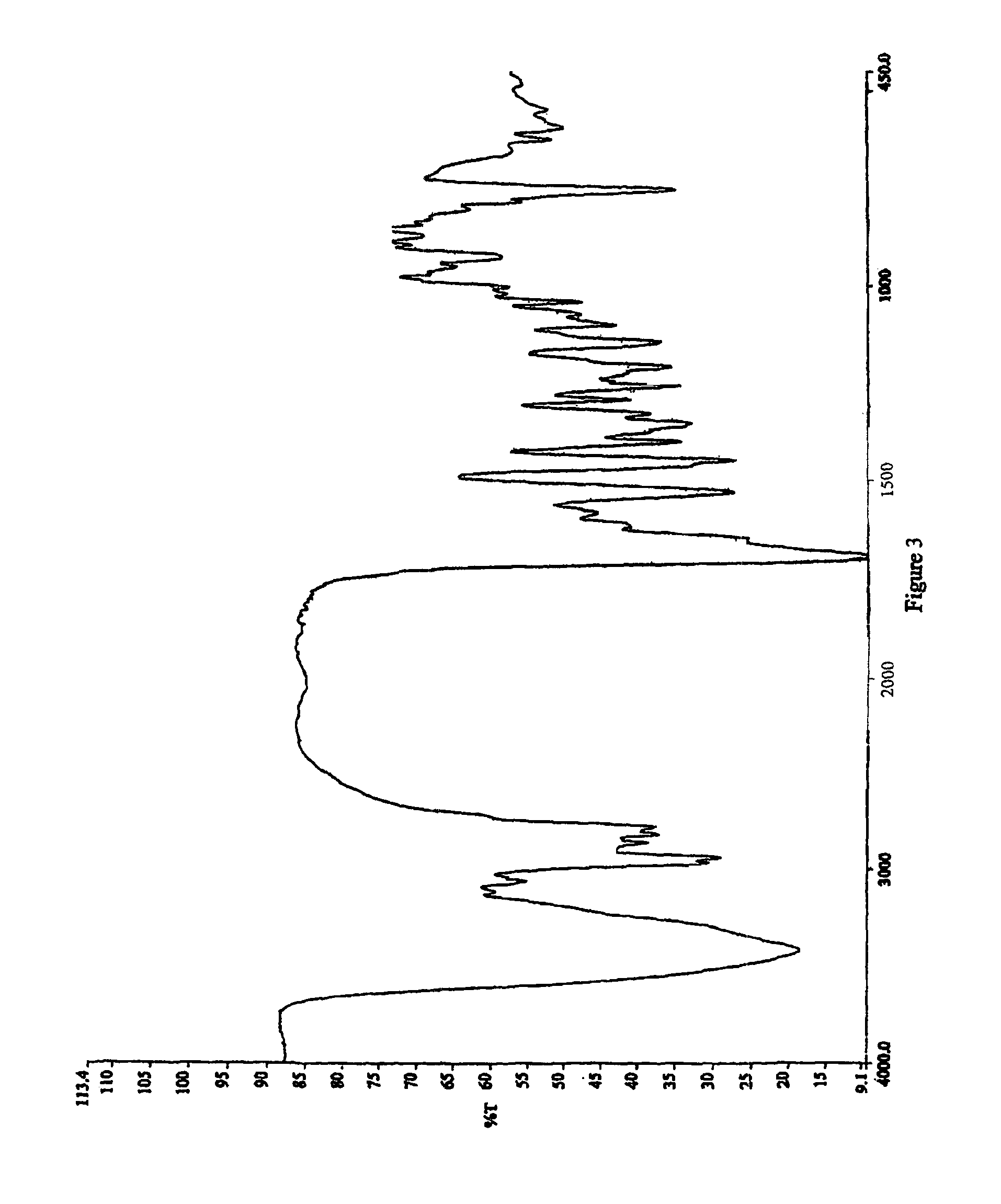Process for the preparation of cabergoline
a technology of cabergoline and process, applied in the field of process for the preparation of cabergoline, can solve the problems of reducing yield, presenting a serious hazard for the large-scale preparation of cabergoline, and reducing the yield, so as to achieve mild reaction, short reaction time, and high yield
- Summary
- Abstract
- Description
- Claims
- Application Information
AI Technical Summary
Benefits of technology
Problems solved by technology
Method used
Image
Examples
example 1
Synthesis of 1,6-di(tert-butoxycarbonyl)-ergoline-8β-carboxylic acid methyl ester (XVI, R1=methyl, R2=tert-butyl)
[0091]To a solution of 13.05 g (48.2 mmol) of ergoline-8β-carboxylic acid methyl ester (XIII, R1=methyl) in 400 ml of dichloromethane 20 ml of triethylamine, 1.0 g of 4-dimethylaminopyridine, 42.1 g (193.1 mmol) of di-tert-butyl dicarbonate was sequentially added, and the reaction mixture was stirred at 40° C. for 5 hours. The mixture was cooled to ambient temperature and it was washed with 3×100 ml of sodium chloride solution. The organic layer was dried over anhydrous sodium sulphate, and concentrated in vacuum. Crystallization from hexane gave 21.6 g (95.2%) of the title compound.
[0092]1H NMR (CDCl3, TMS, 500 MHz) δ 1.46 (s, 9H, N(6)-COOC(CH3)3); 1.66 (s, 9H, N(1)-COOC(CH3)3); 1.88 (td, 1H, J=13.1 Hz, 9.5 Hz, Hβ-9); 2.81 (ddd, 1H, J=13.1 Hz, 3.7 Hz, Hα-9); 2.86-2.94 (m, 1H, H-8); 3.06 (ddd, 1H, J=14.9 Hz, 11.6 Hz, 2.1 Hz, Hα-4); 3.14 (td, 1H, J=13.2 Hz, 3.6 Hz, H-10); ...
example 2
Synthesis of N-[3-(dimethylamino)propyl]-1,6-di(tert-butoxycarbonyl)-ergoline-8β-carboxamide XVII, R2=tert-butyl)
[0093]A mixture of 14.7 g (31.24 mmol) 1.6-di(tert-butoxycarbonyl)-ergoline-8β-carboxylic acid methyl ester (XVI, R1=methyl, R2=tert-butyl), 58.8 ml of 3-(dimethylamino)propyl-amine, 29.4 ml of 2-propanol and 3.68 g of 2-hydroxypyridine was stirred at 70° C. for 8 hours. The reaction mixture was cooled to ambient temperature, and 230 ml of dichloromethane was added. The resulting mixture was washed with 3×120 ml of sodium chloride solution. The organic layer was dried over anhydrous sodium sulphate. The dried solution was either subjected to the subsequent step without isolation of the product or it was concentrated in vacuum to give 16.4 g (97.1%) of the title compound.
[0094]1H NMR (CDCl3, TMS, 500 MHz) δ 1.47 (s, 9H, N(6)-COOC(CH3)3); 1.62 (td, 1H, J=13.1 Hz, 10.4 Hz, Hβ-9); 1.67 (s, 9H, N(1)-COOC(CH3)3); 1.66-1.76 (m, 2H, CONHCH2CH2CH2N(CH3)2); 2.25 (s, 6H, CONHCH2CH2C...
example 3
Synthesis of N-[3-(dimethylamino)propyl]-N-[(ethylamino)carbonyl)-1,6-di(tert-butoxycarbonyl)-ergoline-8β-carboxamide (XVIII, R2=tert-butyl)
[0095]To a solution of 15.5 g (28.67 mmol) of N-[3-(dimethylamino)propyl]-1,6-di(tert-butoxycarbonyl)-ergoline-8β-carboxamide (XVII, R2=tert-butyl) in 350 ml of dichloro-methane 0.8 g of triphenylphosphine, 0.3 g of copper(I) chloride and 6.8 ml (86 mmol) of ethyl isocyanate was sequentially added, and the reaction mixture was stirred at 35° C. for 4 hours. The reaction mixture was concentrated in vacuum and the product was purified on a silica plug to give 16.9 g (96.4%) of the title compound.
[0096]1H NMR (CDCl3, TMS, 500 MHz) δ 1.19 (t, 3H, J=7.5 Hz, CONHCH2CH3); 1.46 (s, 9H, N(6)-COOC(CH3)3); 1.66 (s, 9H, N(1)-COOC(CH3)3); 1.78-1.96 (m, 2H, CONCH2CH2CH2N(CH3)2); 1.98 (td, 1H, J=13.0 Hz, 9.9 Hz, Hβ-9); 2.29 (s, 6H, CONCH2CH2CH2N(CH3)2); 2.32-2.52 (m, 2H, CONCH2CH2CH2N(CH3)2); 2.77 (ddd, 1H, J=13.2 Hz, 7.1 Hz, 3.7 Hz, Hα-9); 3.12-3.24 (m, 2H, H...
PUM
| Property | Measurement | Unit |
|---|---|---|
| temperature | aaaaa | aaaaa |
| temperature | aaaaa | aaaaa |
| temperature | aaaaa | aaaaa |
Abstract
Description
Claims
Application Information
 Login to View More
Login to View More - R&D
- Intellectual Property
- Life Sciences
- Materials
- Tech Scout
- Unparalleled Data Quality
- Higher Quality Content
- 60% Fewer Hallucinations
Browse by: Latest US Patents, China's latest patents, Technical Efficacy Thesaurus, Application Domain, Technology Topic, Popular Technical Reports.
© 2025 PatSnap. All rights reserved.Legal|Privacy policy|Modern Slavery Act Transparency Statement|Sitemap|About US| Contact US: help@patsnap.com



